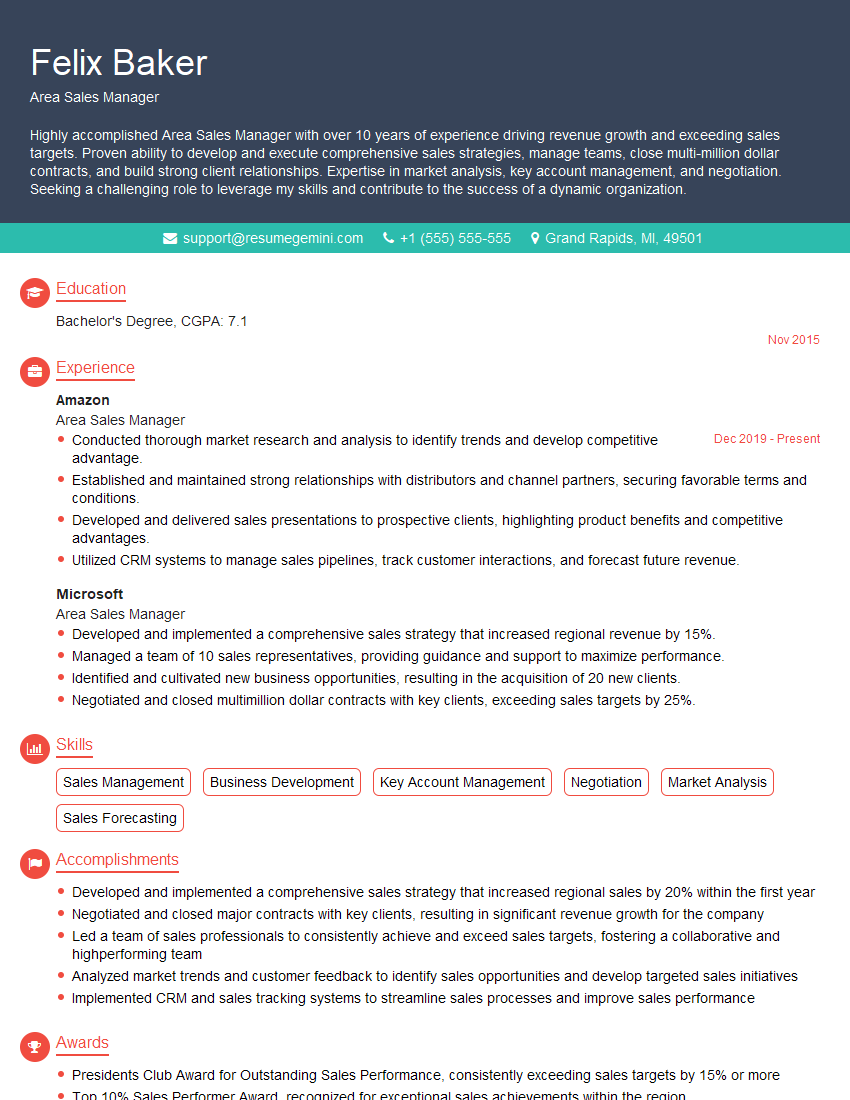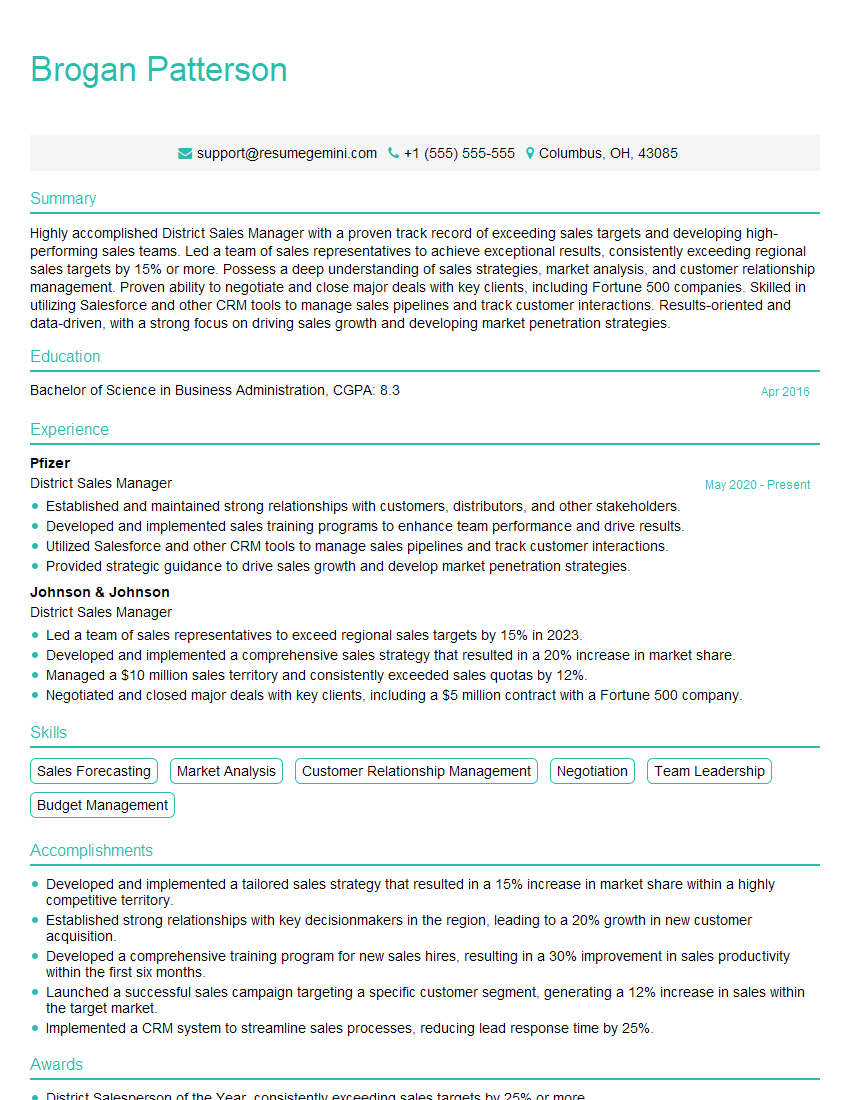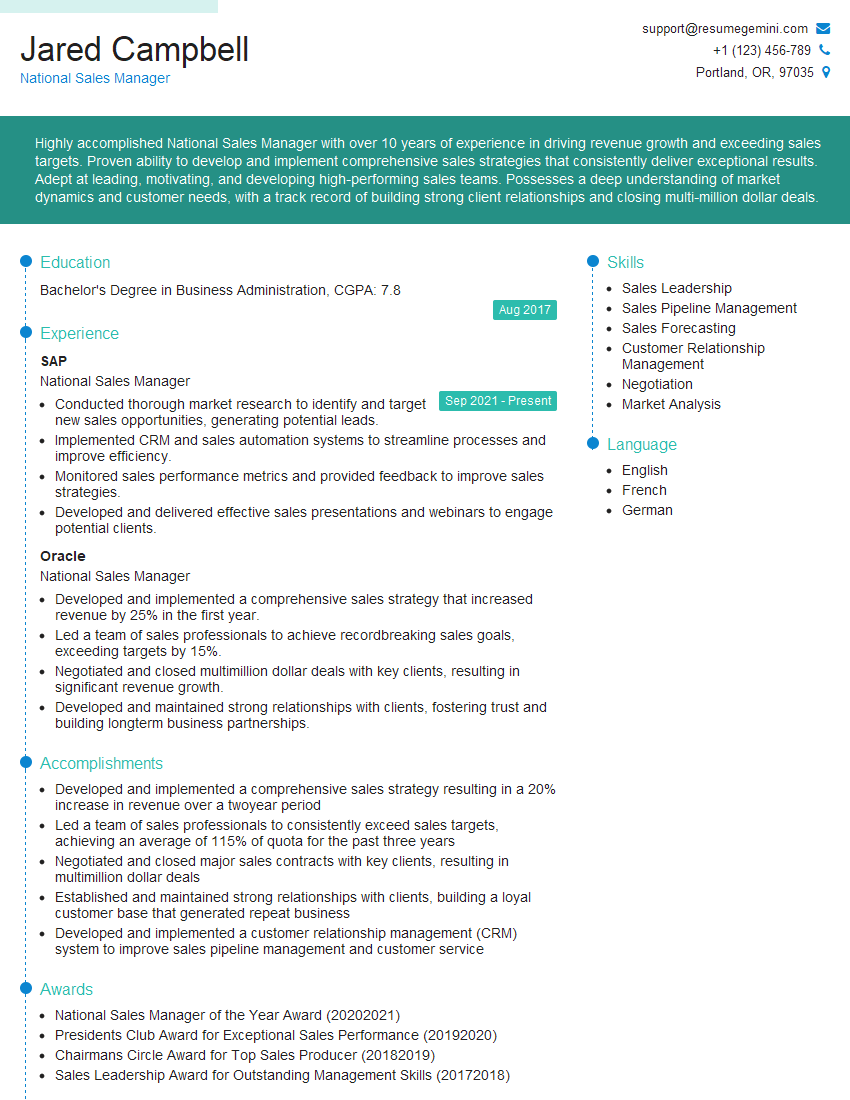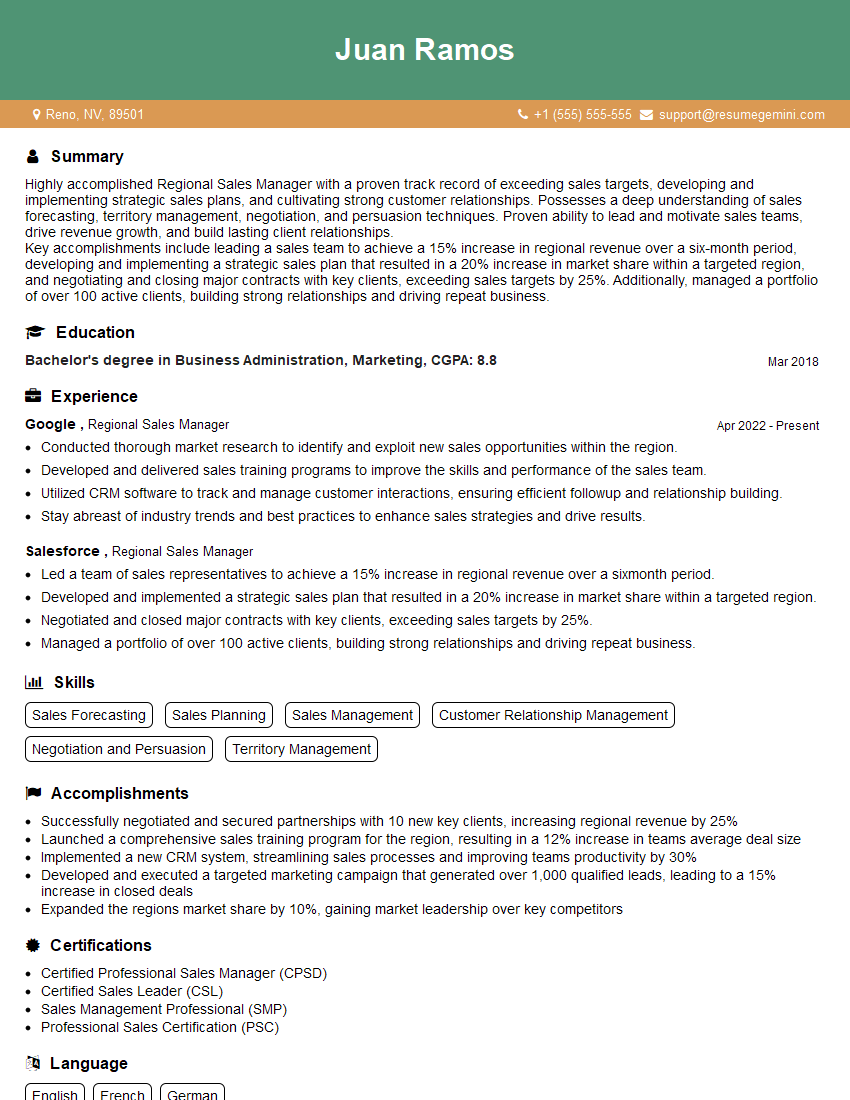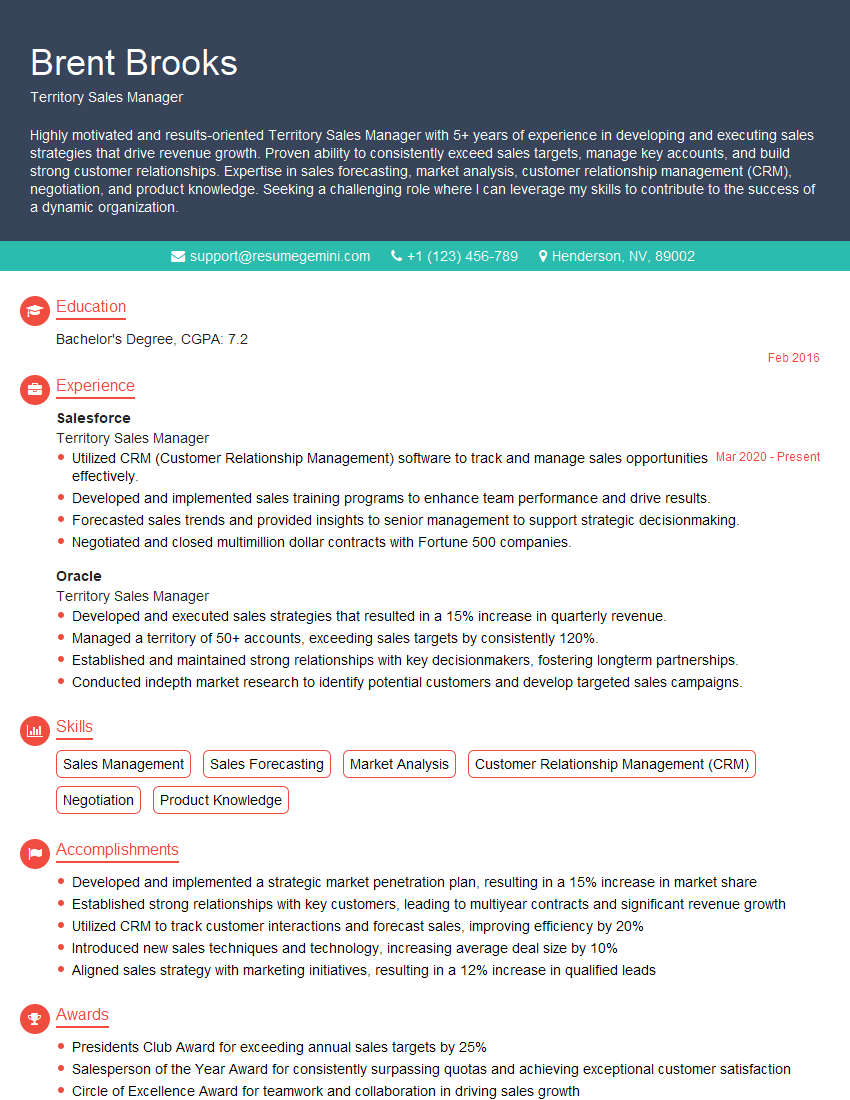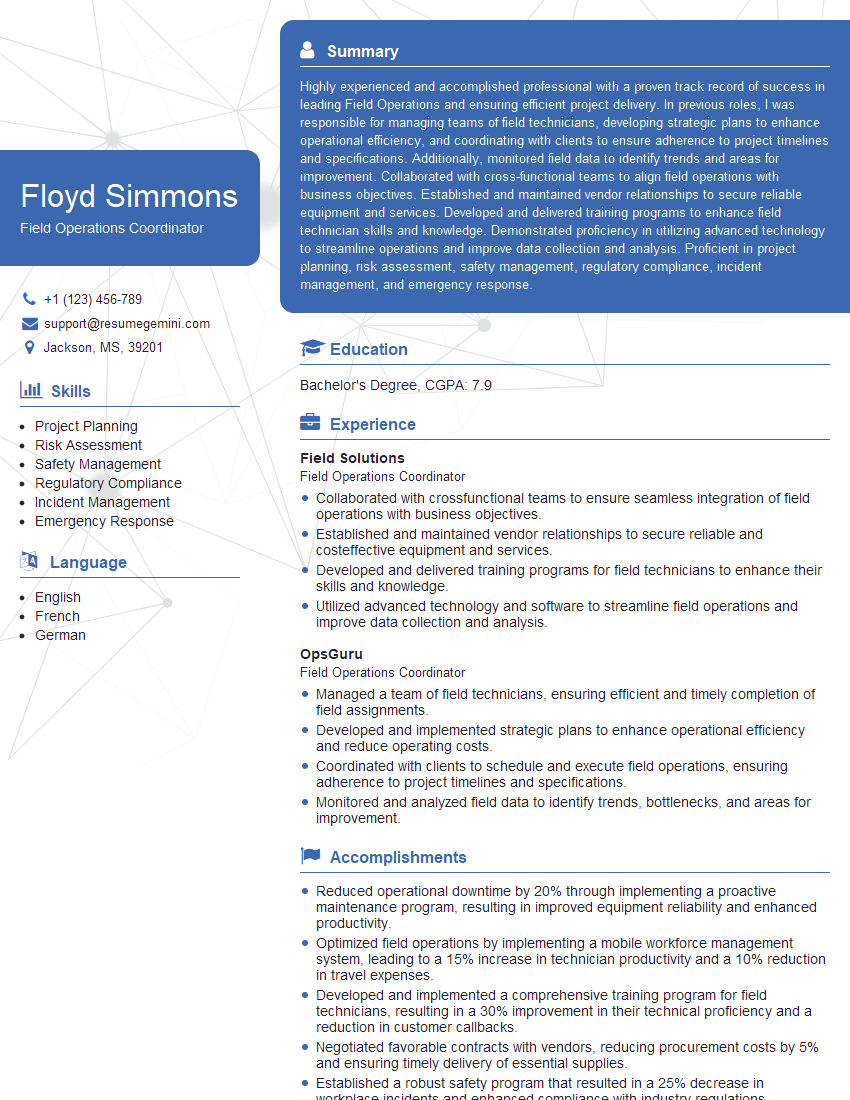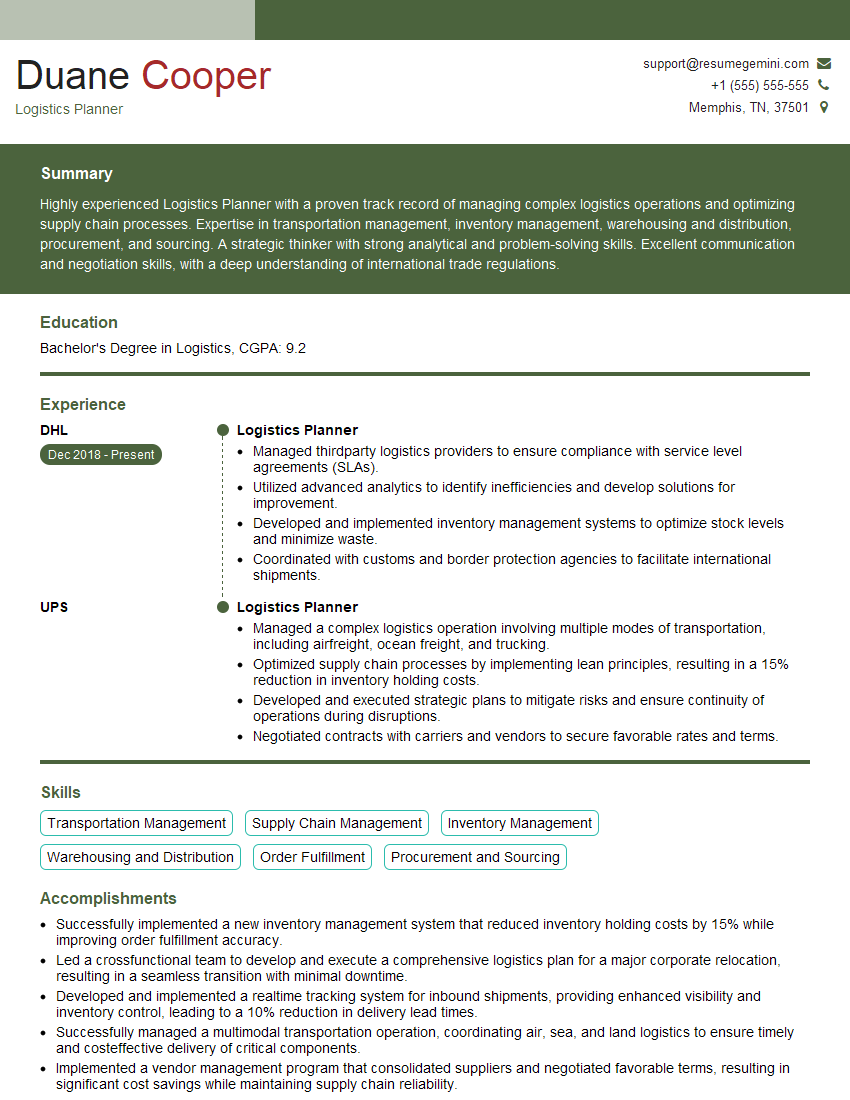Feeling uncertain about what to expect in your upcoming interview? We’ve got you covered! This blog highlights the most important Field Planning interview questions and provides actionable advice to help you stand out as the ideal candidate. Let’s pave the way for your success.
Questions Asked in Field Planning Interview
Q 1. Explain your experience with different field planning software and tools.
My experience with field planning software spans a variety of tools, from basic route optimization software like Route4Me and OptimoRoute to more comprehensive solutions such as Salesforce Field Service and ServiceMax. I’ve also worked with custom-built solutions tailored to specific business needs. Each platform offers unique strengths. For instance, Route4Me excels in its straightforward route optimization capabilities, prioritizing speed and efficiency. More complex platforms like Salesforce Field Service offer integrated CRM functionality, allowing for seamless scheduling and tracking of field technicians alongside customer relationship management. My experience extends to using these tools not only for route planning but also for workforce management, real-time tracking, and performance analysis. I’ve learned to appreciate the nuanced differences in their functionalities and how to select the most appropriate tool based on project requirements and budget.
For smaller scale projects, I’ve successfully utilized spreadsheet-based planning, integrating Google Maps API for distance calculations. This approach provided a basic, cost-effective solution. However, for larger, more complex operations, the robust features of enterprise-level software are invaluable. Understanding these various tools allows me to choose the right solution for optimal efficiency.
Q 2. Describe your process for optimizing field service routes.
Optimizing field service routes is a multifaceted process. It begins with data collection: gathering all relevant job locations, time windows, service durations, technician skills, and any constraints like traffic patterns or delivery restrictions. Once this data is compiled, I leverage route optimization software to generate the most efficient routes, often employing algorithms such as the Traveling Salesperson Problem (TSP) or its variants. This process aims to minimize travel time, fuel consumption, and overall operational costs. It’s crucial to consider factors beyond simple distance, including traffic conditions (using real-time data feeds), appointment scheduling windows, and technician expertise to match job requirements.
For example, imagine a team of electricians with varying specialties. The optimization process would not only consider the geographical proximity of jobs but also ensure each electrician is assigned tasks that match their expertise to minimize travel time and improve efficiency. Post-optimization, I frequently review the generated routes for any inconsistencies or potential improvements, and sometimes manual adjustments are needed to account for unforeseen circumstances, like road closures.
Q 3. How do you handle unexpected events or disruptions in field operations?
Handling unexpected events is paramount in field planning. My approach involves proactive measures and reactive strategies. Proactively, I incorporate buffer time into schedules, anticipate potential delays (weather forecasts, traffic alerts), and maintain open communication channels with field teams. Reactively, I utilize real-time tracking to monitor field operations and quickly identify disruptions. When an unexpected event occurs—a technician’s vehicle breakdown, an extended service time, or an emergency call—I immediately assess the situation’s impact on the overall schedule.
I then use the software’s dynamic rerouting capabilities to adjust routes in real-time. This might involve reassigning tasks to nearby technicians, extending service windows, or communicating directly with customers to manage expectations. Transparent communication with both the field team and customers is critical to mitigate any negative impact. I also document all disruptions and their resolutions for future analysis to identify trends and potential improvements in our preparedness.
Q 4. How do you measure the effectiveness of your field planning strategies?
Measuring the effectiveness of field planning strategies involves a combination of quantitative and qualitative methods. Quantitatively, I track key performance indicators (KPIs) such as the average travel time per job, total fuel consumption, customer satisfaction ratings, and on-time service rates. Qualitative measures involve gathering feedback from field technicians, assessing workflow efficiency based on observations, and analyzing the frequency and impact of disruptions. This allows me to build a holistic understanding of how effectively the strategies are performing.
For instance, if average travel time increases despite optimized routes, it could signal an issue with inaccurate job location data or insufficient buffer time in the scheduling process. Analyzing customer satisfaction scores helps gauge the overall impact on the customer experience. By combining quantitative and qualitative data, I gain a complete picture of performance, enabling evidence-based adjustments to my field planning strategies.
Q 5. What are some key performance indicators (KPIs) you track in field planning?
Key performance indicators (KPIs) I track in field planning include:
- Average travel time per job: Measures efficiency of routes.
- On-time service rate: Indicates adherence to schedules.
- First-time fix rate: Shows the effectiveness of service execution.
- Customer satisfaction (CSAT) scores: Reflects the customer experience.
- Fuel consumption: Monitors operational costs and environmental impact.
- Technician utilization rate: Tracks the percentage of time technicians are actively working.
- Number of missed appointments: Highlights scheduling inefficiencies.
- Average response time to service requests: Measures responsiveness to customer needs.
These KPIs are crucial for assessing the effectiveness of the field planning process and identifying areas for improvement. Regular monitoring and analysis of these metrics allow for data-driven decisions, enhancing overall field operation efficiency.
Q 6. Explain your understanding of territory management and allocation.
Territory management and allocation involve strategically dividing a geographical area into manageable territories and assigning them to field teams. Effective territory management considers factors like population density, customer concentration, service demand, and travel time. The goal is to ensure equitable workload distribution, minimize travel time, and maximize service efficiency. This involves analyzing historical data to identify areas of high and low demand, and using GIS mapping tools to visualize the territories and optimize their boundaries.
For example, a telecommunications company might divide a city into territories based on customer density and the concentration of network infrastructure. This allows technicians to service more customers within a shorter timeframe, improving response times and customer satisfaction. Regular review and adjustment of territories are necessary to adapt to changes in customer base, demand, and workforce size. Utilizing advanced analytical tools to simulate different allocation strategies helps optimize the overall efficiency and effectiveness of operations.
Q 7. How do you balance workload distribution amongst field teams?
Balancing workload distribution is crucial for maintaining team morale and optimizing overall efficiency. This involves considering various factors, including individual technician skills, experience levels, and current workloads. I employ several strategies to ensure fair and efficient workload allocation. Firstly, I utilize software functionalities that automatically distribute tasks based on proximity, skills, and availability, aiming for an equal distribution of job assignments across the team.
Secondly, I actively monitor technician workloads in real-time. If one team member consistently faces a heavier workload than others, I re-allocate tasks to ensure a more even distribution. This might involve prioritization, reassigning tasks, or adjusting service windows. Regular team meetings and open communication channels allow technicians to flag potential imbalances or challenges in their workload, fostering a collaborative approach to maintaining equilibrium and preventing burnout.
Q 8. Describe your experience with forecasting and demand planning in the field.
Forecasting and demand planning in the field are crucial for optimizing resource allocation and ensuring efficient service delivery. It involves predicting future demand based on historical data, market trends, and other relevant factors. This prediction then informs decisions about staffing levels, inventory management, and route optimization.
My experience includes using various forecasting methods, such as time series analysis, moving averages, and exponential smoothing, to predict demand for different services or products in various geographic areas. For example, in a previous role supporting a large telecommunications company, I used historical data on service calls, combined with seasonal trends and marketing campaigns, to forecast technician workload. This allowed us to proactively adjust staffing levels and prevent service delays during peak periods. We also incorporated machine learning techniques to improve forecast accuracy over time, resulting in a 15% reduction in service response times.
I also have experience building and utilizing demand planning models that incorporate various factors affecting demand, such as weather patterns (for outdoor service calls), promotional activities, and economic indicators. These models help anticipate fluctuations in demand and allow for more accurate resource allocation.
Q 9. How do you ensure field teams have access to the necessary resources?
Ensuring field teams have the necessary resources is fundamental to successful field operations. This involves a multi-faceted approach encompassing logistical planning, technological support, and communication strategies.
- Logistical Planning: This includes procuring and distributing equipment, supplies, and vehicles in a timely and efficient manner. This often involves managing inventory levels at various depots or strategically located hubs. For example, in a previous role, we implemented a just-in-time inventory system, reducing storage costs and ensuring that field teams always had the necessary tools and parts.
- Technological Support: Equipping field teams with appropriate technology, such as mobile devices, GPS tracking systems, and specialized software, is critical. This enables efficient communication, data collection, and real-time monitoring of field operations. Regular maintenance and technical support are crucial to ensure reliable system performance.
- Communication Strategies: Clear and consistent communication channels are vital. This can range from daily briefings and progress updates through dedicated communication tools to access to relevant information and troubleshooting via a support system. For example, utilizing a centralized communication platform allows for streamlined information sharing and ensures everyone is working from the same information.
Q 10. Explain your approach to managing field team productivity.
Managing field team productivity involves a combination of monitoring, motivation, and optimization. My approach focuses on a data-driven methodology, supported by effective communication and team empowerment.
- Data-Driven Monitoring: Tracking key performance indicators (KPIs) such as task completion rates, service times, and customer satisfaction scores is essential to identify areas for improvement. Tools like CRM software and field service management platforms are essential for this.
- Effective Communication: Regular feedback, both positive and constructive, is crucial. This can be achieved through one-on-one meetings, team briefings, and performance reviews. Transparency about company goals and individual performance is key.
- Process Optimization: Identifying and eliminating bottlenecks and inefficiencies in workflows is critical for increasing productivity. This involves analyzing data to identify areas where process improvements could be made, such as streamlining workflows or implementing new technologies.
- Empowerment and Training: Investing in the training and development of field teams is crucial. Providing them with the necessary skills and knowledge empowers them to work more efficiently and effectively. This includes cross-training to provide team flexibility.
For instance, in a previous project, I analyzed field team data and identified that a significant portion of time was spent on administrative tasks. By implementing a new software solution that automated some of these tasks, we saw a 10% increase in overall productivity.
Q 11. How do you handle conflicting priorities in field planning?
Conflicting priorities in field planning are inevitable. My approach to handling them is based on prioritization frameworks and effective communication.
- Prioritization Frameworks: Using methods like the Eisenhower Matrix (urgent/important) helps to categorize tasks and allocate resources effectively. This ensures that the most critical tasks are addressed first.
- Data-Driven Decision Making: Utilizing data analytics to understand the impact of each task on overall objectives helps to make informed decisions about prioritization.
- Stakeholder Communication: Open communication with all stakeholders (clients, management, field teams) is crucial to ensure everyone understands the prioritization decisions and the reasoning behind them. This often involves finding compromises or renegotiating expectations.
- Flexibility and Adaptability: The ability to adapt to changing circumstances is key. Unexpected events may require a shift in priorities, and a flexible approach allows for seamless adjustments.
For example, if an unexpected emergency arose, requiring immediate attention, I would temporarily re-allocate resources from lower-priority tasks to address the urgent issue, communicating these changes to all affected parties.
Q 12. Describe a time you had to solve a complex field planning problem.
In a previous role, we faced a significant challenge during a large-scale product rollout. Unexpectedly high demand in certain regions caused significant delays and threatened to impact customer satisfaction.
The problem was two-fold: (1) Insufficient resources in high-demand areas and (2) inaccurate initial demand forecasts. To solve this, I employed a multi-pronged approach:
- Real-time Data Analysis: I implemented a system to track real-time demand fluctuations using data from our customer service team and sales data. This provided a clear picture of the areas experiencing the most significant backlog.
- Resource Re-allocation: Based on real-time data, I re-allocated resources from lower-demand areas to those experiencing bottlenecks. This involved coordinating with logistics and field teams to ensure a smooth transition.
- Improved Forecasting: I analyzed the reasons for the inaccurate forecast, adjusting our models to incorporate real-time data and refining our understanding of factors impacting demand, like social media trends and competitor activities.
- Communication and Collaboration: I ensured constant communication with all stakeholders – management, field teams, and customers – to manage expectations and maintain transparency.
This combined approach enabled us to mitigate the impact of the high demand, minimizing delays and preventing significant customer dissatisfaction. The experience highlighted the importance of real-time data analysis, flexible resource allocation, and proactive communication in handling complex field planning challenges.
Q 13. How do you incorporate data analytics into your field planning process?
Data analytics plays a central role in modern field planning. I utilize data analytics to gain insights into various aspects of field operations, improving efficiency and optimizing resource allocation.
- Predictive Modeling: Using historical data and advanced analytical techniques (e.g., machine learning) to predict future demand, identify potential bottlenecks, and optimize resource allocation. This allows for proactive planning and minimizes disruptions.
- Performance Monitoring: Tracking key performance indicators (KPIs) such as field team productivity, service times, customer satisfaction, and resource utilization to identify areas for improvement and measure the effectiveness of interventions.
- Route Optimization: Utilizing geographical information systems (GIS) and algorithms to optimize field team routes, reducing travel time and fuel consumption. This leads to significant cost savings and increased efficiency.
- Resource Allocation: Analyzing data on workload, skills, and availability to optimally allocate field resources to meet demand and minimize downtime.
For instance, by analyzing historical service call data, we were able to identify patterns in customer requests, allowing us to adjust staffing levels and schedules accordingly. This led to a significant reduction in customer wait times and an increase in field technician efficiency.
Q 14. What is your experience with capacity planning in a field environment?
Capacity planning in a field environment involves determining the optimal level of resources needed to meet anticipated demand while considering various constraints, such as available personnel, equipment, and budget.
My experience includes developing and implementing capacity plans that incorporate:
- Demand Forecasting: Accurate forecasting of future workload based on historical data, seasonal trends, and market conditions. This forms the basis for capacity planning.
- Resource Availability: Assessing the availability of personnel, equipment, and other resources to determine capacity constraints.
- Service Level Agreements (SLAs): Considering SLAs to ensure that field operations meet required service levels (e.g., response times, resolution times).
- Contingency Planning: Incorporating contingency plans to address unexpected events, such as equipment failures, staff absences, or surge in demand. This includes having reserve resources or alternative plans in place.
- Optimization Techniques: Utilizing optimization techniques (e.g., linear programming, simulation) to allocate resources efficiently and maximize capacity utilization. This is often done using specialized software.
For example, in a previous role, I developed a capacity plan for a large-scale infrastructure project. This involved forecasting demand for various skilled tradespeople, procuring necessary equipment, and scheduling work in a way that minimized delays and ensured the project was completed on time and within budget. The plan included contingency plans for potential delays or resource shortages.
Q 15. Describe your process for developing and implementing field planning strategies.
Developing and implementing field planning strategies is a multifaceted process that requires a deep understanding of the operational environment, resource availability, and strategic objectives. My approach follows a structured methodology encompassing several key phases:
- Needs Assessment & Goal Definition: This initial stage involves a thorough analysis of the current operational landscape, including identifying key performance indicators (KPIs), understanding existing limitations, and defining clear, measurable, achievable, relevant, and time-bound (SMART) goals for the field planning strategy. For example, if the goal is to increase service efficiency by 15%, we’d quantify this by reducing average service call response time.
- Data Gathering & Analysis: Here, we collect relevant data such as historical service records, geographical data, customer demographics, and resource availability (personnel, equipment, vehicles). This data is then analyzed to identify patterns, trends, and potential bottlenecks. We might use statistical analysis to understand peak demand periods or spatial analysis to pinpoint areas requiring increased resource allocation.
- Strategy Design & Optimization: Based on the data analysis, we design the field planning strategy. This includes defining territories, assigning tasks to field personnel, scheduling service calls, and optimizing routes. We leverage tools such as route optimization software and GIS to ensure efficiency and minimize travel time. For instance, we’d use algorithms to create the most efficient routes, considering traffic patterns and road conditions.
- Implementation & Monitoring: The strategy is implemented, and continuous monitoring is critical. We track KPIs and make adjustments as needed. Regular performance reviews and feedback from field teams are incorporated to refine the strategy continuously. For example, we might adjust schedules based on real-time feedback about unexpected delays or urgent requests.
- Evaluation & Refinement: Regular evaluation helps assess the effectiveness of the implemented strategy. This involves comparing actual results against the predefined SMART goals, identifying areas for improvement, and iteratively refining the process. This step is crucial for continuous improvement and maximizing efficiency.
This iterative process ensures that the field planning strategy remains dynamic and adapts to evolving operational needs.
Career Expert Tips:
- Ace those interviews! Prepare effectively by reviewing the Top 50 Most Common Interview Questions on ResumeGemini.
- Navigate your job search with confidence! Explore a wide range of Career Tips on ResumeGemini. Learn about common challenges and recommendations to overcome them.
- Craft the perfect resume! Master the Art of Resume Writing with ResumeGemini’s guide. Showcase your unique qualifications and achievements effectively.
- Don’t miss out on holiday savings! Build your dream resume with ResumeGemini’s ATS optimized templates.
Q 16. How do you prioritize tasks and projects in field planning?
Prioritizing tasks and projects in field planning involves a combination of strategic and operational considerations. I employ a framework that considers several key factors:
- Urgency and Impact: Tasks are prioritized based on their urgency (how quickly they need to be completed) and their impact on overall objectives. A high-impact, high-urgency task takes precedence. For example, addressing a critical equipment failure at a key customer site would outrank a routine maintenance task.
- Resource Availability: Prioritization also considers the availability of resources like personnel, equipment, and budget. Tasks requiring resources that are currently unavailable are deferred until resources become available.
- Dependencies: Tasks with dependencies on other tasks are sequenced appropriately. For example, a site survey needs to be completed before installation can begin.
- Risk Assessment: Tasks with higher risk profiles, such as working in hazardous environments, often require prioritization to ensure safety and mitigation of potential problems.
- Strategic Alignment: Tasks are aligned with the overall strategic goals of the organization. Those that contribute most directly to achieving these goals are prioritized higher.
I often use tools like project management software to visualize task dependencies, track progress, and manage priorities effectively. Techniques like the Eisenhower Matrix (urgent/important) also provide a helpful framework for decision-making.
Q 17. How familiar are you with geographical information systems (GIS) in field planning?
I am highly proficient in using Geographical Information Systems (GIS) for field planning. GIS provides invaluable tools for visualizing, analyzing, and managing spatial data, which is crucial in optimizing field operations. My experience includes using GIS for:
- Territory Management: Defining optimal service territories based on factors such as population density, customer locations, and travel times.
- Route Optimization: Designing efficient routes for field technicians to minimize travel time and fuel consumption. This often involves using advanced algorithms within GIS software.
- Resource Allocation: Identifying areas with high demand and strategically allocating resources accordingly. For instance, if we see a clustering of service requests in a specific area through GIS heatmaps, we can allocate more resources there.
- Risk Assessment: Analyzing environmental factors like terrain, weather conditions, and potential hazards using GIS layers to assess risks and plan accordingly.
- Data Visualization: Creating maps and dashboards to visualize key performance indicators (KPIs) such as service response times, technician workload, and customer satisfaction.
I am familiar with various GIS software packages, including ArcGIS and QGIS, and am comfortable using their analytical and visualization capabilities to enhance field planning and decision-making.
Q 18. What is your experience with different scheduling methodologies?
My experience encompasses various scheduling methodologies, each with its strengths and weaknesses depending on the context. I have used:
- First-Come, First-Served (FCFS): Simple to implement but can lead to inefficient resource allocation, especially during peak demand periods.
- Priority Scheduling: Tasks are prioritized based on urgency or importance, which is better than FCFS but requires careful prioritization criteria.
- Shortest Processing Time (SPT): Optimizes resource utilization by prioritizing tasks with the shortest processing times, improving overall throughput.
- Critical Path Method (CPM): A network scheduling technique that identifies the critical path (longest sequence of dependent tasks) and helps manage project timelines effectively, often used for larger, complex projects.
- Resource Leveling: A technique that aims to smooth out resource demands over time, preventing over-allocation and improving resource utilization.
The choice of scheduling methodology is always context-dependent. For example, in a high-volume service environment, SPT might be beneficial, while for a large capital project, CPM would be more appropriate. My expertise lies in selecting the most suitable methodology for the given scenario and fine-tuning it to optimize performance.
Q 19. How do you ensure compliance with relevant regulations in field operations?
Ensuring compliance with relevant regulations in field operations is paramount. My approach involves a multi-pronged strategy:
- Thorough Regulatory Knowledge: I stay updated on all applicable federal, state, and local regulations related to the industry. This includes safety regulations, environmental regulations, and any specific regulations pertaining to the type of field operations involved.
- Compliance Training: I ensure that all field personnel receive comprehensive training on relevant regulations and safe operating procedures. This training is regularly reviewed and updated to reflect any changes in legislation or best practices.
- Documentation and Record-Keeping: Meticulous record-keeping is crucial. All activities, inspections, and maintenance are documented thoroughly to demonstrate compliance. This documentation serves as evidence in case of audits or inspections.
- Audits and Inspections: Regular internal audits and inspections are conducted to identify potential compliance gaps and ensure that procedures are being followed correctly. This proactive approach helps prevent violations.
- Incident Reporting and Investigation: A robust system for reporting and investigating incidents is vital. This allows for identification of root causes and implementation of corrective actions to prevent future occurrences.
Compliance is not merely a regulatory obligation but a critical component of responsible operations that protects the company, its employees, and the environment.
Q 20. Explain your experience with resource allocation and optimization.
Resource allocation and optimization are central to efficient field planning. My experience involves a data-driven approach, leveraging both quantitative and qualitative factors:
- Demand Forecasting: Accurate demand forecasting is critical. This involves analyzing historical data, considering seasonal variations, and anticipating future demand to ensure that sufficient resources are available when and where they are needed. Techniques like time series analysis are valuable here.
- Resource Capacity Planning: This involves assessing the availability and capacity of different resources, including personnel, equipment, and vehicles. This helps determine the feasibility of meeting projected demands.
- Optimization Algorithms: I use various optimization algorithms (linear programming, integer programming, etc.) to allocate resources efficiently, minimizing costs while maximizing productivity. Software packages like R or Python with optimization libraries are frequently used for this purpose.
- Real-time Monitoring and Adjustment: Real-time tracking of resource utilization allows for dynamic adjustments as needed. Unexpected events or changes in demand may require reallocation of resources to maintain optimal performance.
- Performance Measurement: Key performance indicators (KPIs) such as resource utilization rate, task completion time, and cost per task are monitored to evaluate the effectiveness of the resource allocation strategy and identify areas for improvement.
Effective resource allocation is a continuous process requiring careful planning, monitoring, and adaptation based on real-world feedback and performance data.
Q 21. Describe your communication strategies for keeping field teams informed.
Effective communication is essential for keeping field teams informed and engaged. My strategy uses a multi-channel approach tailored to the specific needs of the team and the information being conveyed:
- Regular Team Meetings: Scheduled meetings provide a forum for sharing updates, addressing concerns, and fostering team cohesion. These meetings can be in-person or virtual, depending on the circumstances.
- Mobile Communication Technology: Utilizing mobile apps and communication platforms allows for real-time updates, task assignments, and instant communication. This can involve using dedicated field service management software.
- Email and Messaging Systems: Emails and messaging systems are used for disseminating non-urgent information, such as schedules, policy updates, and administrative announcements.
- Digital Dashboards and Reporting: Providing field teams with access to digital dashboards showcasing key performance indicators (KPIs) and progress updates fosters transparency and allows them to track their own performance.
- Feedback Mechanisms: Implementing systems for feedback collection, such as surveys or suggestion boxes, enables continuous improvement and addresses concerns proactively. Two-way communication is essential.
The key to successful communication is tailoring the method to the message and audience. Clear, concise, and timely communication builds trust and promotes effective collaboration, resulting in improved field operations.
Q 22. How do you handle issues with equipment or supplies in the field?
Handling equipment or supply issues in the field requires a proactive and systematic approach. It’s not just about fixing immediate problems; it’s about preventing future ones. My process begins with establishing clear communication channels. Field personnel are empowered to report issues immediately through a designated system, whether it’s a mobile app, a direct line to a logistics team, or a simple, easily accessible reporting form.
Next, we have established protocols for different issue levels. Minor issues, like a low battery in a GPS unit, are handled on-site with readily available spares. More significant issues, such as a broken piece of specialized equipment, trigger a formal escalation process involving our central logistics department. This department works to assess the situation, identify the best solution – repair, replacement, or alternative method – and expedite the necessary resources. For instance, if a crucial piece of surveying equipment fails in a remote location, we might deploy a replacement via air freight and arrange for expedited repair of the damaged equipment.
Preventive maintenance is key. Regular equipment checks and scheduled servicing significantly reduce unforeseen issues. We track equipment usage and maintenance history meticulously, utilizing a computerized maintenance management system (CMMS) to schedule preventative tasks and predict potential failures. This allows us to proactively address potential problems before they disrupt operations.
Q 23. What is your experience with various field planning models?
My experience encompasses a range of field planning models, each tailored to specific project needs. I’m proficient in using route optimization models, particularly when dealing with large territories and multiple field teams. This involves leveraging software to minimize travel time and distance, thereby maximizing efficiency. For example, I’ve used algorithms that consider traffic patterns, terrain, and service windows to plan efficient routes for meter readers.
I’ve also worked extensively with territory management models, optimizing the assignment of territories to individual field personnel based on factors like population density, sales potential, and team capacity. Here, geographical information systems (GIS) are invaluable. For instance, we use GIS to create heatmaps of customer concentration, helping us define territories that balance workload and ensure equitable coverage.
Furthermore, I’m familiar with resource allocation models that optimize the distribution of equipment, personnel, and supplies across various field projects. This often involves linear programming or simulation techniques to ensure resource availability when and where they are needed most. For example, in a large-scale infrastructure project, I’ve used simulation to anticipate resource needs during peak demand periods, ensuring that teams are adequately staffed and equipped.
Q 24. How do you adapt your field planning strategies to different market conditions?
Adapting field planning strategies to different market conditions is crucial for success. My approach is to leverage data and market intelligence to understand the shifting landscape. We continuously monitor key indicators like sales trends, customer behavior, economic conditions, and even competitor activity. This data is incorporated into our field planning models. For example, during economic downturns, we might adjust territories to focus on high-potential areas, and we might prioritize high-value customers requiring more frequent visits.
In volatile markets, dynamic planning becomes essential. We utilize flexible scheduling and routing systems, allowing us to quickly adapt to changes in demand or unexpected disruptions. For instance, during a natural disaster, we can rapidly re-route field teams to prioritize affected areas or those requiring emergency services. We also invest in robust communication systems to ensure rapid response to changing circumstances and facilitate collaboration amongst field teams.
Furthermore, we incorporate risk assessment into our planning, identifying potential obstacles such as political instability, regulatory changes, or weather events and developing contingency plans to mitigate their impact on field operations.
Q 25. Describe your process for training and onboarding new field personnel.
Training and onboarding new field personnel is a multi-stage process focusing on both technical skills and company culture. It begins with a comprehensive orientation that covers company policies, safety procedures, and expectations. This orientation is followed by role-specific training that covers software, equipment, and specific tasks. For instance, new technicians receive hands-on training in using the diagnostic equipment, practicing troubleshooting and repair techniques.
We utilize a blended learning approach, combining classroom instruction with online modules and on-the-job training. Experienced field personnel act as mentors, providing guidance and support during the initial deployment phase. We establish clear performance goals and provide regular feedback, monitoring progress through performance reviews. This ensures new employees acquire necessary skills efficiently and smoothly integrate into their roles. We also incorporate role-playing scenarios and simulations to prepare field staff for challenging situations.
Finally, regular refresher training and professional development opportunities ensure field personnel stay up-to-date with the latest technologies, best practices, and regulatory requirements, fostering continuous improvement.
Q 26. How do you ensure the safety and well-being of field personnel?
Ensuring the safety and well-being of field personnel is paramount. We begin by implementing a robust safety program with clearly defined procedures and guidelines. This program includes regular safety training, covering topics like hazard identification, risk assessment, and emergency response. We also equip our field teams with appropriate personal protective equipment (PPE) and provide regular inspections to ensure its proper use. We use mobile technology to track field personnel’s location and ensure their safety through real-time monitoring.
We implement strict adherence to safety protocols, especially in high-risk environments. For example, teams working in hazardous areas undergo specialized safety training and receive comprehensive risk assessments specific to the job location. Before every field task, a detailed safety briefing occurs to address potential challenges. We encourage a strong safety culture where personnel feel comfortable reporting hazards and near misses without fear of reprisal.
Finally, we have emergency response plans in place, including emergency contact numbers and procedures for handling accidents or emergencies. We regularly conduct safety audits and drills to ensure our procedures are effective and personnel are prepared.
Q 27. How do you measure the return on investment (ROI) of your field planning efforts?
Measuring the ROI of field planning efforts requires a multi-faceted approach. We track key performance indicators (KPIs) such as sales growth, customer satisfaction, operational efficiency, and cost savings. For example, we compare sales figures before and after implementing new route optimization strategies to assess the increase in sales due to improved efficiency. We also monitor customer feedback to gauge the impact of field visits on customer satisfaction.
We also analyze operational metrics such as reduced travel time, decreased fuel consumption, and lower equipment maintenance costs to demonstrate cost savings. These are compared against the investments made in field planning technologies and personnel training. For example, the investment in new routing software can be compared to the cost savings resulting from decreased fuel consumption and labor hours.
A balanced scorecard approach provides a holistic view of ROI, considering financial, operational, and customer-related metrics. We use data analytics to gain insights into the effectiveness of different strategies and to identify areas for improvement.
Q 28. How do you stay current on best practices and new technologies in field planning?
Staying current on best practices and new technologies is an ongoing process. I regularly attend industry conferences and workshops, engaging with peers and experts to learn about emerging trends and innovations. We subscribe to industry publications and online resources, keeping abreast of the latest research and developments.
Our team actively participates in professional organizations, which often host webinars and training sessions on cutting-edge technologies. We actively evaluate new field planning software and tools, often through pilot programs, to assess their suitability for our operations and potential cost savings. For example, we recently piloted a new augmented reality application to support field technicians in complex equipment repairs.
Finally, we encourage continuous learning within the team. We foster a culture of experimentation and knowledge sharing, enabling our team to adapt quickly to new developments and technologies in the field.
Key Topics to Learn for Field Planning Interview
- Territory Management & Allocation: Understanding strategies for optimizing sales territories, considering factors like geography, customer density, and sales potential. Practical application: Analyzing existing territory maps to identify inefficiencies and propose improvements.
- Route Optimization & Scheduling: Mastering techniques to plan efficient routes for field representatives, minimizing travel time and maximizing productivity. Practical application: Using route planning software and applying algorithms to optimize visit schedules.
- Demand Forecasting & Sales Projections: Developing accurate sales forecasts based on historical data, market trends, and customer insights. Practical application: Utilizing statistical models and forecasting techniques to predict future demand.
- Resource Allocation & Budget Management: Efficiently allocating resources (personnel, budget, materials) to support field operations. Practical application: Creating and managing a budget for field activities, optimizing spending while ensuring operational efficiency.
- Data Analysis & Reporting: Collecting, analyzing, and interpreting data from field operations to identify trends, measure performance, and inform decision-making. Practical application: Using data visualization tools to create compelling reports that highlight key performance indicators (KPIs).
- Field Sales Support & Collaboration: Understanding the crucial role of supporting field sales teams through effective planning and resource provision. Practical application: Developing strategies to improve communication and collaboration between field representatives and the central office.
- Technology & Tools in Field Planning: Familiarity with various software and tools used in field planning, such as CRM systems, mapping software, and route optimization platforms. Practical application: Demonstrating experience using or willingness to learn such tools.
Next Steps
Mastering Field Planning is crucial for career advancement in sales, marketing, and operations. A strong understanding of these principles demonstrates your ability to strategize, optimize resources, and drive sales growth. To significantly enhance your job prospects, creating an ATS-friendly resume is essential. ResumeGemini is a trusted resource to help you build a professional and impactful resume that highlights your skills and experience effectively. Examples of resumes tailored to Field Planning are provided to guide you through the process.
Explore more articles
Users Rating of Our Blogs
Share Your Experience
We value your feedback! Please rate our content and share your thoughts (optional).
What Readers Say About Our Blog
Hello,
We found issues with your domain’s email setup that may be sending your messages to spam or blocking them completely. InboxShield Mini shows you how to fix it in minutes — no tech skills required.
Scan your domain now for details: https://inboxshield-mini.com/
— Adam @ InboxShield Mini
Reply STOP to unsubscribe
Hi, are you owner of interviewgemini.com? What if I told you I could help you find extra time in your schedule, reconnect with leads you didn’t even realize you missed, and bring in more “I want to work with you” conversations, without increasing your ad spend or hiring a full-time employee?
All with a flexible, budget-friendly service that could easily pay for itself. Sounds good?
Would it be nice to jump on a quick 10-minute call so I can show you exactly how we make this work?
Best,
Hapei
Marketing Director
Hey, I know you’re the owner of interviewgemini.com. I’ll be quick.
Fundraising for your business is tough and time-consuming. We make it easier by guaranteeing two private investor meetings each month, for six months. No demos, no pitch events – just direct introductions to active investors matched to your startup.
If youR17;re raising, this could help you build real momentum. Want me to send more info?
Hi, I represent an SEO company that specialises in getting you AI citations and higher rankings on Google. I’d like to offer you a 100% free SEO audit for your website. Would you be interested?
Hi, I represent an SEO company that specialises in getting you AI citations and higher rankings on Google. I’d like to offer you a 100% free SEO audit for your website. Would you be interested?
good
